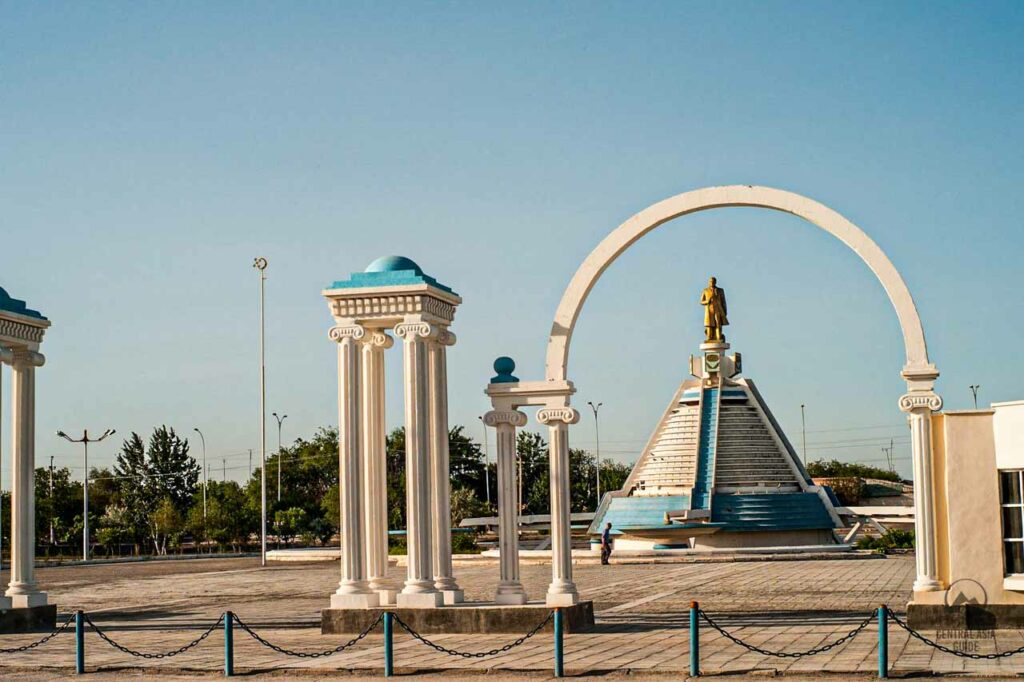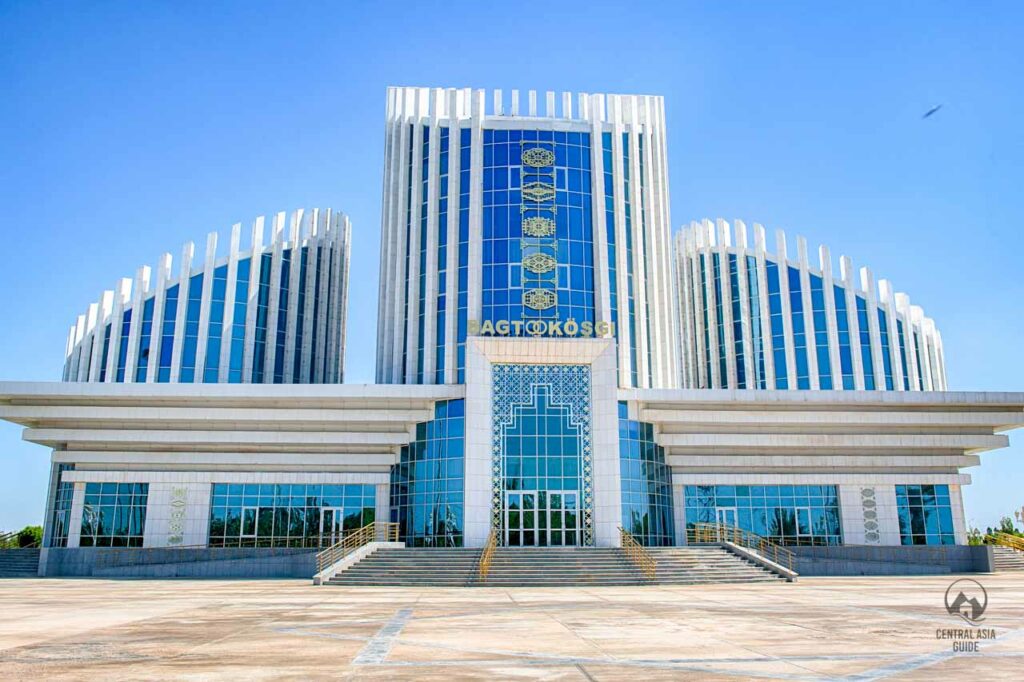Dashoguz
Dashoguz City
Dashoguz also spelled Dashhovuz, is the administrative center of the Dashoguz Region in northern Turkmenistan. With a population of around 160,000, the city has evolved significantly over the years. Its name has seen various iterations, once known as Tashauz before a 1999 presidential decree standardized it as Dashoguz for both the city and the region.
The earliest evidence of a settlement in Dashoguz dates back to the early 19th century when the area was part of the Khanate of Khiva. At the time, Dashoguz played a strategic role in maintaining control over the local Turkmen tribes. The modern city began to take shape during the Soviet era in the 1920s. Construction was concentrated along the southern banks of the Shabat Canal, a vital waterway in the region.


Dashoguz’s Development and Strategic Regional Importance
Dashoguz, the capital of the Dashoguz Region in northern Turkmenistan, has grown into a pivotal center of commerce, culture, and infrastructure. Its development reflects both its historical significance and strategic location near the border with Uzbekistan.
Dashoguz developed as a typical Soviet industrial hub, characterized by wide streets, functional architecture, and a centrally planned layout. The city features an orderly downtown area with Soviet-style designs, showcasing its historical roots in the socialist urban planning of the era. While Dashoguz maintains its industrial core, modern infrastructure and cultural institutions have added a new dimension to the city.
Situated near the border with Uzbekistan, Dashoguz serves as a key gateway for trade and travel between the two countries. Its proximity to significant historical sites, such as the UNESCO-listed ruins of Kunya-Urgench, makes it an important base for cultural tourism in the region.
Dashoguz Sights
Dashoguz, though not a primary tourist destination, offers a few interesting sights and serves as a vital transport hub for travelers exploring northern Turkmenistan and nearby Uzbekistan. The city’s expansive layout, marked by wide boulevards and Soviet-era architecture, provides a glimpse into its unique character and history.
The city center features a sprawling boulevard flanked by imposing concrete buildings, reflecting its Soviet heritage. While some areas appear underdeveloped, the broad streets and open spaces are emblematic of Soviet urban planning. These features make Dashoguz an intriguing stopover for travelers heading to or from Ashgabat and Uzbekistan.
Dashoguz Bazaars
For a taste of local life, the Bai Bazaar is a must-visit. This vibrant market offers an array of goods, including fresh produce, clothing, household items, and unique local crafts. The lively atmosphere provides a perfect opportunity to interact with locals and immerse yourself in the region’s culture.

The Bai Bazaar, officially known as the Dayhan (Peasant) Bazaar. It is located off Gurbansoltan Eje Street, a couple of blocks north of the Shabat Canal. Accessing the bazaar through the finely carved wooden doors on the western side, the small bar on your left sells locally produced Concord beer. This remarkable liquid is produced by a Dashoguz entrepreneur using home-brew kits imported from Britain.
If you are staying at the Hotel Uzboy, you might check out Ak Bazaar over the road. The main, domed building is virtually deserted, save for a shop making wedding dresses. The bazaar itself is round the back: a shrine to car parts, with rows of radial tires, headlights and shock absorbers. There is an out-of-town market, the Shor Bazaar, just to the east of the town gate on the Konye-Urgench road, but it is not really worth the trip out.
Museum of Bagshies
The Museum of Bagshies in Dashoguz, Turkmenistan, is a unique cultural landmark dedicated to preserving and promoting the rich heritage of Turkmen folk musicians and storytellers, known as bagshies. As the only museum of its kind in the country, it plays a vital role in celebrating traditional vocal and musical arts, attracting tourists and cultural enthusiasts from around the world.
The Museum of Bagshies showcases an impressive collection of over 2,000 artifacts and exhibits that highlight the evolution of Turkmen musical arts over more than a century. Visitors can explore an array of traditional musical instruments, such as the dutar, gijak, and tuiduk, alongside historical photographs and documents that narrate the stories of legendary bagshies. The museum also features thematic displays like “Zenan-Bagshies,” which spotlight the contributions of female performers such as Akjagul Myradova and Sulgun Meretgeldiyeva
The museum is deeply rooted in the cultural identity of the Dashoguz region. It hosts events to commemorate iconic bagshies, including centenary celebrations and musical performances inspired by their works. For example, Akjagul Myradova, a celebrated female performer of destans (epic tales), is prominently featured in the museum’s collection and programming, reflecting her profound impact on Turkmen musical tradition

Glory Museum
Glory Museum was opened on the Victory Day in 1984 to honor the veterans of the Great Patriotic War. The main exhibit of the museum is dedicated to local war heroes, centered around the busts of four such Heroes of the Soviet Union. One of them is Saparmurat Hojayev, who survived the war to become a teacher. His civilian suit, replete with dozens of medals, is preserved in a glass case. His wheelchair is also on display as the fighting claimed one of his legs.
Behind the Glory, Museum stands a tiled column topped with a Soviet star. An eternal flame burns in front of it. There is a dedication to those killed in the building of Soviet power, and inscriptions recording the names of some of those on the Bolshevik side who lost their lives during the Civil War.
Gateway to Regional Attractions
Dashoguz is primarily used as a base for exploring nearby historical and cultural landmarks. Key destinations include: Kunya-Urgench: A UNESCO World Heritage Site and one of Central Asia’s most significant archaeological locations, featuring ancient monuments from the Khorezm Empire. Izmukshir Fortress: The remnants of a once-magnificent fortress that dates back over 2,000 years.
How to get to Dashoguz
Plane
Dashogus airport is located 14 km south of the city. There are daily flights from Ashgabat to Dashogus that take about 50 minutes but make sure to book early as this is a very popular route. Despite the relatively large number of flights, all on Boeing 717 aircraft, it can be fiendishly difficult to get a ticket. Arrive early for your flight as there are many stories of overbookings. Turkmenistan Airlines also flies to Turkmenbashi and Mary from Dashoguz. As you enter the terminal building from your plane, your passport will be checked by border guards for the appropriate restricted zone permit.
Train
The Dashoguz train station is on Woksal street, about 600 m east of Gurbansoltan street.
One slow train per day travels from Dashoguz to Konye-Urgench taking four hours and leaving at 7.05 am daily and another train to Ashgabat at 11.15 am daily (platskartny/kupe ) taking 20 hours. The rail line to Ashgabat was built on sand without foundation, forcing trains to crawl at very slow speeds. There is a rail line to Turkmenabat but a lack of demand has suspended services and currently trains from Turkmenabat only go as far as Gazachak.
Bus / Taxi
The Dashoguz bus station is near the Bai Bazaar, in the northern section of the city.
Buses go from Dashoguz to Konye-Urgench (3M, two hours) and Ashgabat (30M, nine hours). Buses for Turkmenabat are not always available so you need to check prior. Shared taxis leave from outside the train station.
Sights near Dashoguz
Sights near Dashoguz in Uzbekistan
Page updated 11.12.2024